I am frequently asked how to remove a hole cane seat, easily. So I thought that might make a good topic here on the Weavin’ Wicker Woman blog.
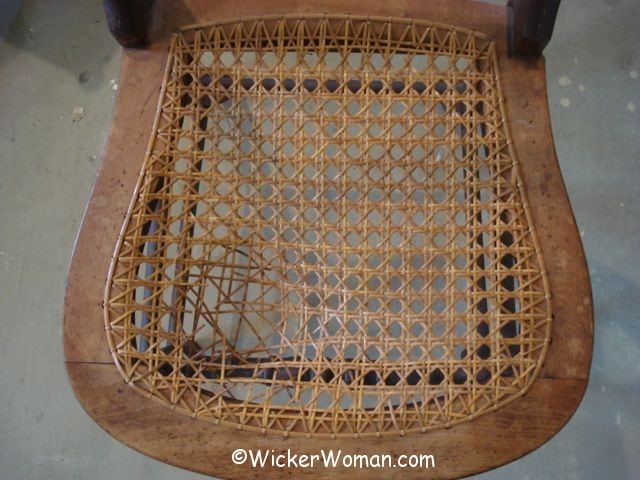
First thing is to assess the cane seat and take pictures
It’s always a good thing to take pictures of the chair and seat before you remove anything.
By taking pictures first, you can assess the overall condition of the chair itself, see if it needs regluing or has any missing parts, or needs to be refinished.
You can also examine the cane pattern to see where and maybe why it failed in the first place. And if the weaving pattern was at fault, you will then know what “not” to do when you reweave.
Or maybe the wrong size cane was used and was too weak to support the sitter?
Maybe the previous weaver didn’t bevel the inside edge of the frame and the cane broke at that spot?
Many links on this website are affiliate links, which means if you click my link and then purchase an item, I receive a small commission at no extra cost to you.
Next Step–Cut and remove all cane loops, strands and binder
After taking pictures and close examination of the chair is to turn it upside-down and cut the individual cane loops on the bottom of the chair seat.
Be careful you don’t scratch or damage the wood when you use your sharp basketry scissors or utility knife/box cutter to do this.
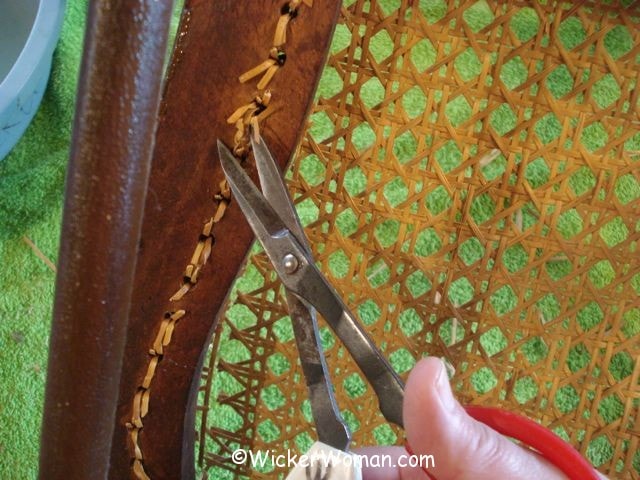
Are there a lot of knots on the underside? Cut them off, too otherwise, it will make taking the strands out from the top side more difficult.
Then I turn the chair right-side up again and using either a pair of basketry scissors (putsy and takes forever) or a box cutter/utility knife
, (faster method) I cut out the woven cane from the center of the seat.
Next, cut the binder cord and loops in the holes. Afterward, with your hand, you can pull on the binder cord and most of it will come up easily.
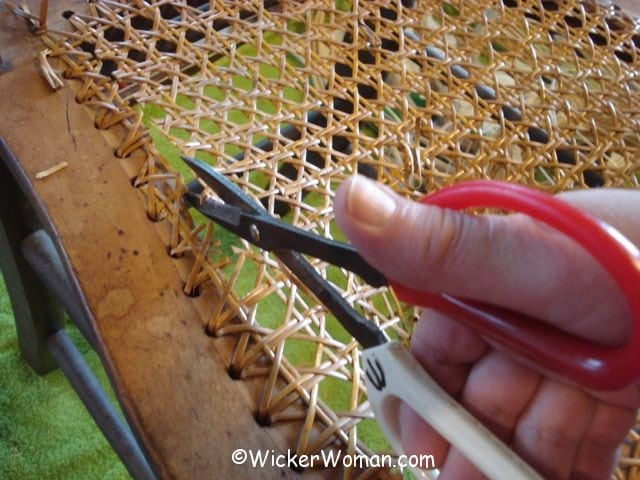
Finally–Clean out all holes and remaining cane strands
Pick out all the remaining cane sections and binder cord from the holes using your hands and/or a pair of pliers, don’t forget to remove the cane from the bottom side also.
If you still have some stubborn cane in the holes, you can use a caning awl, tin punch or even a drill
to remove them.
Drills are especially handy if you have stubborn or glue-filled holes, to force the cane out from the top side, down.
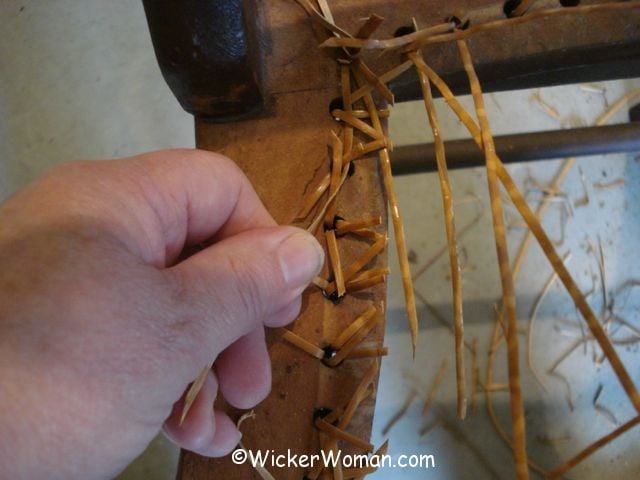
Hole-to-hole Cane Seat with Woven Cane Removed
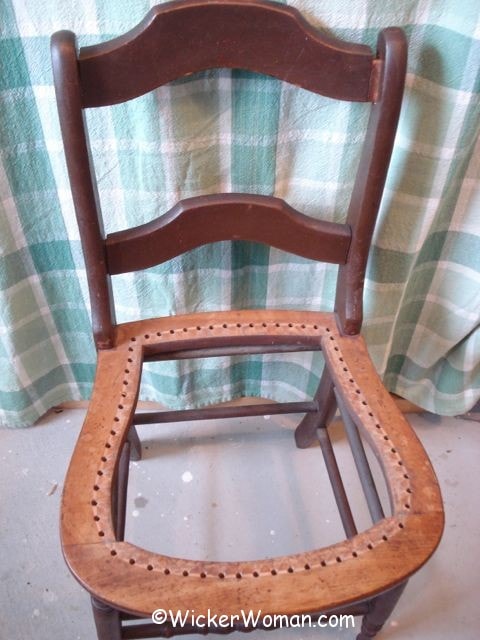
Oops!–Remember to always bevel the inside frame edge
Before you begin weaving your chair caning project, there’s one more step to complete.
Remember to always bevel or round off the inside frame edge using a wood rasp, file or Stanley Sureform Shaver
tool, or sander.
If you forget this step it’s possible that the cane will be cut by the sharp 90º edge and break prematurely, causing the seat to fail.
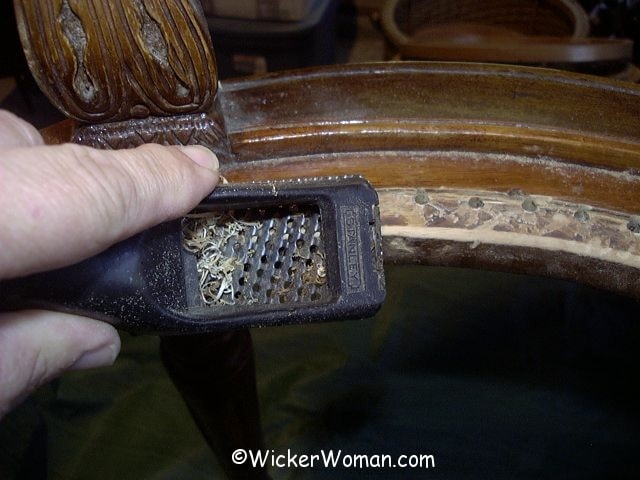
Here’s a little Chair Caning Tip of the Day Video to see what I mean by beveling the inside edge of the seat.
Now the seat is all done and you’re ready to weave that new hole-to-hole cane seat!
RELATED: Weaving the 7-steps of Hole-to-Hole Caning
Congratulations on a job well done!
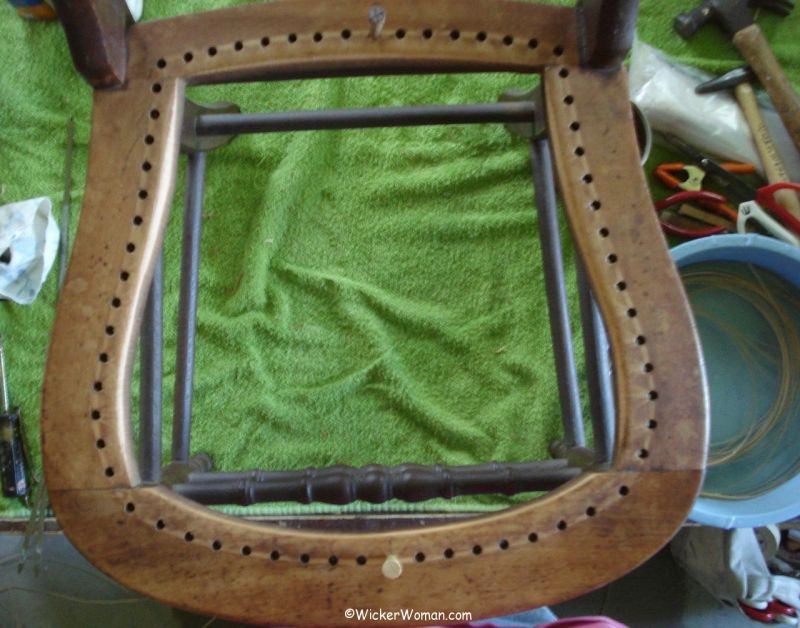

~~ Live Well, Laugh Often, Love Much ~~
Until next time, Happy Weaving!

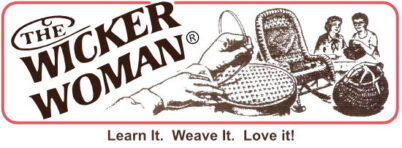



We have two kitchen chair seats that have webbing but NO holes! The seat webbing is held in by what looks to me like bamboo pressed into a channel made in the sturdy wood frame and probably glued to hold the cane. How it was tightened I cannot understand. Two seats are fine, but two have stretched out.
Hey there Sue,
Let’s see if I can point you in the right direction for help with your sagging kitchen chair seats. If your cane seat chairs have webbing instead of holes, then you are dealing with a completely different material and weaving technique than the one I was referring to in the blog post. This blog post talks about weaving a chair seat with holes drilled in the perimeter of the chair frame and is called, hole-to-hole caning.
If your chair has webbing or a sheet of cane and it’s held in place by a spline then it’s called cane webbing, sheet cane, or machine cane. To remove the cane and spline, there are certain steps to take that are very different from removing cane from a hole-to-hole cane chair seat.
Please take a look at How to Remove Cane Webbing on this page. As far as How to Care for Your Cane Furniture, this page has all the hints and tips you’ll need to keep them in tip-top shape.
And if you ever need the seats professionally repaired/replaced, check with the experts on my National Furniture Repair Directory™/a>
Hope this helps! Remember too, that you can always use the Search feature on the right sidebar and at the bottom of every page, to help you find topics you are interested in!
I have an old, tall wooden porch rocker which someone had redone the seat using rope in a weave pattern. My cats have destroyed most of it, making it impossible to sit on. What design or type of weaving or caning should I use? It’s a fairly large chair and the seat is 17X22 with rounded spindles to tie everything to, no holes in other words I have a picture of it but am not sure how to post it on here. At 75 I am still fairly computer illiterate. 🙂
Hello Sceva,
So sorry to hear about the condition of your chair seat. I’m assuming it’s a rush pattern since you mention the round dowels and no holes in the framework.
How much experience do you have in doing seat weaving? If this is your first piece, you will need to get instructions, materials and supplies first.
Take a look at these pages below and see if you can find a similar picture as to your piece and then you’ll know what it is and what material you should use to replace the seat.
Identify Woven Chair Seating Patterns
Variety of Chair Seat Weaving Designs
Then get your supplies, materials and tools from any one of these fine cane & basket companies listed here in the Cane & Basket Supplies Directory™.
If you decide not to do the weaving yourself, check in the National Furniture Repair Directory™ tab at the top of every page in the navigation bar.
Good luck and hope you eventually become a bonified chair seat weaver!
I am re-caning some dining chairs from the 1870s for our home. In doing the caning I am finding the individual strands are breaking at the hole edges in some places. Is it OK to bevel the hole edges a little so the cane is not broken when inserting the pegs? Some of the holes are quite worn are the pegs have to be snug or the strands just come loose. I also considered drilling the holes to even them up. Comments? Ideas?
Scott,
Yes, it’s certainly alright to bevel the inside edges of the drilled holes if you like, certainly won’t hurt anything. But I can’t advise you on drilling more holes to even them up. I’d need to see the chair first and then make my assessment as to whether or not you need more holes. If you’d like, we can schedule a paid consultation. Just go to the Contact page and make your request.
I have an old chair which I hope to replace the seat with sheet cane. I have read many of your tutorials. My question is the seat is basically trapezoid in shape, yet the corners are all rounded. Original install has the spline going around the corner vs. 45 degree cut and mitering the corner. Should I follow suit? Also, do I really need all 3 sizes of chisel? Thank you!
Hello Deb,
Thank you for visiting my site! Yes, you are correct to use one long piece of spline to go into a rounded corner pressed cane seat, just the same as a completely round seat. Make sure the spline is a couple inches longer than needed and either make a butt joint or diagonal join in the back of the seat. You can follow the directions here in my How to Install Cane Webbing Instructions instruction page. And did you see the previous instruction page on How to Remove Cane Webbing Instructions? Hope this helps!